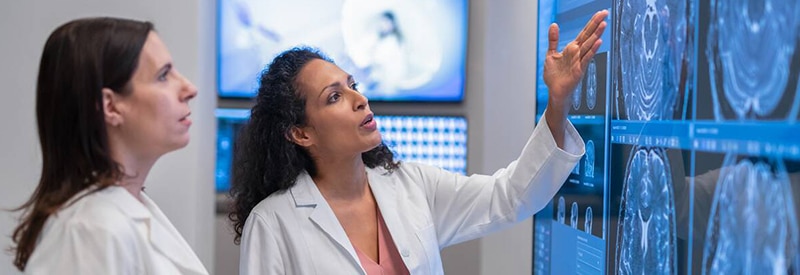
Comprehensive stroke care services in South Tulsa
Hillcrest Hospital South’s neurologists are proud to offer exceptional stroke care services. We are proud to be a certified Primary Stroke Center and a Level II Primary Stroke Center certified by the DNV and accredited by the Oklahoma State Department of Health. Our skilled team provides a variety of high-quality treatments for neurological conditions, illnesses and disorders. We also provide our patients access to endovascular and neurosurgical treatments, as well as stroke rehabilitation services. When you and your loved ones need comprehensive stroke and neurological disorder treatments with a compassionate touch, you can depend on our neurologists to provide just that.
Our stroke center services
Hillcrest South recently received certification as a Primary Stroke Center. This certification speaks to our ability to provide exceptional stroke and neurological services to patients in Tulsa, Oklahoma.
We offer the following services at both locations:
- 24/7 neurology coverage by board-certified neurologists
- Access to nationally recognized specialists
- Emergency stroke care from a rapid response team
- FDA-approved IV clot-busting medication for eligible patients
- Intravenous tissue plasminogen activator (IV tPA) treatment for acute ischemic stroke
- Stroke rehabilitation services
Patients needing endovascular and neurosurgical care will be transferred to Hillcrest Medical Center.
Recognizing the signs of a stroke (BE FAST)
Recognizing the symptoms of a stroke is one of the best ways to stay ahead of the health of you and your loved ones. There are many symptoms of stroke that patients should be aware of. One way to remember the most common symptoms is to BE FAST:
- B – Balance. Is the person suddenly having trouble with balance or coordination?
- E – Eyes. Is the patient experiencing sudden vision troubles? This includes blurred vision, double vision, or loss of sight in one or both eyes.
- F – Face drooping. Ask the person to smile. Is one side of their face numb or drooping?
- A – Arm weakness. Ask the person to raise both arms to the same level. Does one arm drift downward? Is one arm weak or numb?
- S – Speech difficulty. Ask the person to say a sentence. Are they struggling to speak normally?
- T – Time to call 911. If the person is experiencing ANY of these symptoms, call 911 immediately.
Stroke risk factors you should know
Knowing the risks that lead to stroke can help patients prevent one before it ever occurs. According to the American Stroke Association, the following factors contribute to an increased likelihood of experiencing a stroke:
- Atrial fibrillation
- Carotid artery disease
- Diabetes
- Diet
- Heart disease
- High blood pressure
- High cholesterol
- Peripheral artery disease
- Physical inactivity
- Obesity
- Sickle cell anemia
- Sleep apnea
- Smoking
Talk to your doctor about your risk of stroke, and what you can do to maximize your health.

